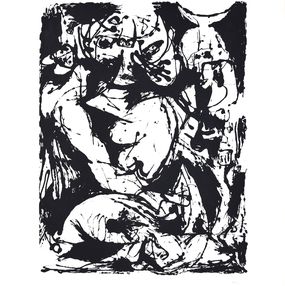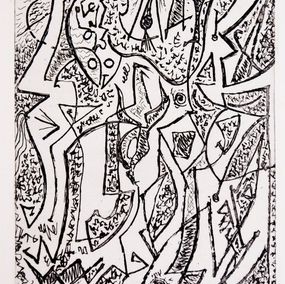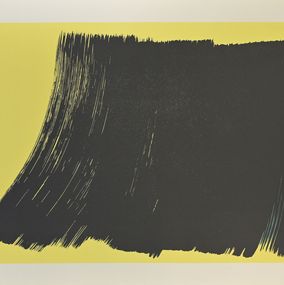
Untitled No. 6,
1964
Jackson Pollock
Print : Screen Print
74 x 58.5 x 0.1 cm 29.1 x 23 x 0 inch
Free returns within 14 days
Authenticity guaranteed
Learn moreSecure payment
About the artwork
Type
Numbered and limited to 50 copies
Signature
Stamped
Authenticity
Sold with certificate of Authenticity from the gallery
Invoice from the gallery
Medium
Dimensions cm • inch
74 x 58.5 x 0.1 cm 29.1 x 23 x 0 inch Height x Width x Depth
Support
Framing
Not framed
Artwork sold in perfect condition
Artwork location: Italy
The artwork is one of the most interesting and emblematic paintings of the artist. In the 1940s, Pollock invented his signature "drip painting". After 1951, Pollock's artworks became darker in color; they belong to a collection painted in black on white or unprimed canvases. These works have been referred to as his "Black Pourings"; he exhibited them at the Betty Parsons Gallery in NYC, but none of them was sold. Today these artworks are considered the most interesting exemplars of Pollock's gestural paintings. The abstract compositions in Pollock’s serigraphs (he made only 11 graphic works) demonstrate his capacity of absorbing parts of art history and reinventing them through a language that allows him to overtake the European figurative tradition. Yet, in moving forward Pollock never leaves anything behind, as confirmed by his colleague and companion Lee Krasner, to whom Pollock confided that he could not stop himself during the creative process, even when some forms began appearing in the painting, because his purpose was in fact to delete any figure.
Paul Jackson Pollock (Cody, 1912 – Long Island, 1956) has been one of the most important artists of the XX century. He was the leading force behind the “School of New York” and Abstract Expressionism. During his life, thanks to the professional relationship with Peggy Guggenheim, Pollock gained considerable fame and notoriety. His greatness lies in the development of a radical totally abstract style in the history of contemporary art. He absolutely redefined the painting and drawing techniques, and found new means to describe space. Pollock grew up in California, where he experienced the native American culture. In 1929, he studied at the Students’ League in New York City and worked in the Regionalist style. In the first years of his career, he was influenced also by Mexican muralist painters such as Diego Rivera and José Clemente Orozco, as well as by some Surrealist artworks realized by Joan Miró and Max Ernst. During an important art exhibition held in 1939 at the Museum of Modern Art in New York, he saw for the first time artworks by Pablo Picasso, including the famous “Guernica” of 1937. Through this exhibition, he understood the importance and the expressive power of European Modernism. He began realizing compositions with semi-abstract and totemic figures, with ritualistic and obsessive reworking. After his premature death in 1957 in Long Island, Jackson Pollock became one of the most important artists in the world.
“Painting is self-discovery. Every good artist paints what he is." - Jackson Pollock.
Reference:
"J. Pollock, Black and White", Marlborough Gallery, New York, March 1969.
Collector’s Guide
Imagine it at home

Discover more by the artist
Presentation
Jackson Pollock is one of the most iconic figures of twentieth-century American art. His techniques influenced an entire school of artists who were then part of the abstract expressionism movement.
Born in 1912 in Wyoming, Pollock grew up in California and Arizona. He was influenced by Navajo ritual dances and sandpainting, which he had observed in Indian reservations in Arizona. Pollock's older brother, Charles, a student at the Otis Art Institute in Los Angeles, gave him a taste for the arts! So much so that Pollock enrolled at Manual Arts High School in 1927. Three years later, the brothers moved to New York together, where Charles introduced Pollock to the work of Mexican muralists such as José Clemente Orozco, David Siqueiros, and Diego Rivera. Pollock also discovered cubism and surrealism. He admired the great European painters such as Pablo Picasso, Joan Miró, and André Masson. Pollock's European influences inspired him to explore mythological themes.
Unfortunately, Pollock's alcohol addiction forced him to seek treatment. There, he was encouraged to use drawing as a form of therapy. Drawing was a method that helped Pollock understand himself and to materialize abstract thoughts like humanity's deepest fears.
Like many surrealists, Pollock practiced automatic writing and tackled much more sizeable formats. In 1943, he met Peggy Guggenheim, who helped him exhibit his work in a gallery in New York. One imposing mural in particular seduced visitors, marking the beginning of Pollock's success...
In 1945, Pollock moved in with his wife and set up his studio in a barn, where his most prominent works were born. His monumental paintings were designed according to his unique techniques: drips, splatters, and splashes that flooded the surface of the canvas. The method was dubbed “all-over" painting. Pollock painted without his brush ever touching the canvas, which earned him the nickname “Jack the Dripper".
Art also lies in the gestures and energy of the artist painter; Pollock used it as a means of external expression and a form of cleansing. This was later called “action painting". After 1952, Pollock reintroduced figurative elements in his paintings and began using the brush again. He was very prolific during his last years of life before a fatal car accident put an end to his artistic momentum in 1956.
The abstract expressionist left behind more than 700 works of art that influenced the greatest painters and changed artistic creation forever.
More works from Wallector Srl
Artsper delivers internationally. The list of countries is available in the first step of your cart.
If your country is not listed contact us at [email protected] and we will see what we can do.
Note that Customs fees may apply for works shipped internationally. This is indicated in the first step of the shopping cart.
You can choose a delivery address different from the billing address. Make sure that a trusted person is present to receive the work if you cannot be there.
Have you purchased a painting, sculpture or work on paper?
Find our expert advice for the conservation and promotion of your works in the articles below:
Artsper offers you access to more than 200,000 works of contemporary art from 2,000 partner galleries. Our team of experts carefully selects galleries to guarantee the quality and originality of the works.
You benefit from:
-
Works at gallery price
-
Return within 14 days, regardless of your location
-
Easy resale of the work purchased on Artsper
-
Personalized research tools (selection and tailor-made universe)
Our customer service is available for any assistance.
At Artsper, our mission is to allow you to collect works of art with complete peace of mind. Discover the protections we offer at every stage of your shopping experience.
Buy works from top galleries
We work in close collaboration with carefully selected art galleries. Each seller on Artsper is carefully examined and approved by our team, thus ensuring compliance with our code of ethics. You therefore have the assurance of purchasing authentic, high-quality works.
Total transparency: you know what you are buying
Before being posted online, all artwork on Artsper is reviewed and validated by our moderation team. You can browse with complete peace of mind, knowing that each piece meets our criteria of excellence.
Personalized support: our experts at your service
Our team of contemporary art experts is available by phone or email to answer all your questions. Whether you want advice on a work or a tailor-made selection to enrich your collection, we are here to support you.
Resell your works with ease
If you have purchased a work on Artsper and wish to resell it, we offer you a dedicated platform to relist it. To find out more, click here.
Make offers with Artsper: negotiate like in a gallery
You have the possibility to propose a price for certain works, just like in a gallery. This feature allows you to initiate discussions and potentially acquire your coins at advantageous prices.
Get help with your negotiations
Our team will negotiate for you and inform you as soon as the best offer is obtained. Do not hesitate to call on our expertise to ensure a transaction at the best price.
Order securely
Artsper satisfaction assurance
We want you to be completely satisfied with your purchase. If the work you receive is not to your liking, you have 14 days to return it free of charge, and you will be refunded in full, whatever the reason.
Secure payment with Artsper partners
All credit card payments are processed by Paybox, the world leader in payment solutions. Thanks to their strict security standards, you can transact with confidence.
Problem Support
In the rare event that an artwork arrives damaged or not as described, we are here to help. Whether for a return, refund, restoration or exchange, our team will support you throughout the process and will ensure that we find the solution best suited to your situation.
Conditions to benefit from Artsper protections:
-
Use one of the payment methods available on Artsper for your order.
-
Report any problems within one week of receiving the work.
-
Provide required photographic evidence (including original artwork and packaging).
Artsper guarantees cover the following cases:
-
The received work lacks a described characteristic (for example, a signature or frame).
-
The artwork has significant differences from its description (e.g. color variation).
-
The work is damaged upon receipt.
-
The work is lost or damaged by the carrier.
-
Delivery is significantly delayed.
With Artsper, you collect with complete peace of mind.
















